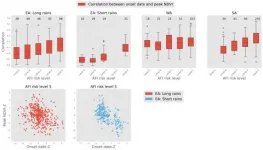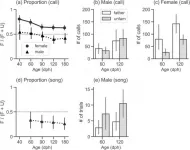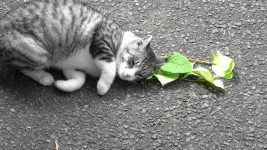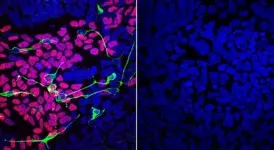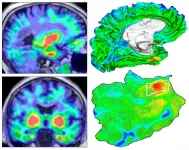On the origins of money: Ancient European hoards full of standardized bronze objects
Early Bronze Age cultures traded in bronze objects of standardized weight
2021-01-20
(Press-News.org) In the Early Bronze Age of Europe, ancient people used bronze objects as an early form of money, even going so far as to standardize the shape and weight of their currency, according to a study published January 20, 2020 in the open-access journal PLOS ONE by Maikel H. G. Kuijpers and C?t?lin N. Popa of Leiden University, Netherlands.
Money is an important feature of modern human society. One key feature of money is standardization, but this can be difficult to identify in the archaeological record since ancient people had inexact forms of measurement compared with today. In this study, the authors assessed possible money from the Early Bronze Age of Central Europe, comparing the objects based on their perceived - if not precise - similarity.
The objects studied were made of bronze in shapes described as rings, ribs, and axe blades. The authors examined more than 5,000 such objects from more than 100 ancient hoards. They statistically compared the objects' weights using a psychology principle known as the Weber fraction, which quantifies the concept that, if objects are similar enough in mass, a human being weighing them by hand can't tell the difference.
They found that even though the objects' weights varied, around 70% of the rings were similar enough to have been indistinguishable by hand (averaging about 195 grams), as were subsets of the ribs and axe blades.
The authors suggest that this consistent similarity in shape and weight, along with the fact that these objects often occurred in hoards, are signs of their use as an early form of standardized currency. Later, in the Middle Bronze Age of Europe, more precise weighing tools appear in the archaeological record along with an increase in scrap bronze, pointing to a developed system of weighing.
The authors add: "The euros of Prehistory came in the form of bronze rings, ribs and axes. These Early Bronze Age artefacts were standardized in shape and weight and used as an early form of money."
INFORMATION:
Citation: Kuijpers MHG, Popa CN (2021) The origins of money: Calculation of similarity indexes demonstrates the earliest development of commodity money in prehistoric Central Europe. PLoS ONE 16(1): e0240462. https://doi.org/10.1371/journal.pone.0240462
Funding: The research was supported by the Talent Programma VICI from the Netherlands Organisation for Scientific Research (NWO https://www.nwo.nl/; Grant number 277-60-001: "Economies of Destruction". The funders had no role in study design, data collection and analysis, decision to publish, or preparation of the manuscript.
Competing Interests: The authors have declared that no competing interests exist.
In your coverage please use this URL to provide access to the freely available article in PLOS ONE: https://journals.plos.org/plosone/article?id=10.1371/journal.pone.0240462
[Attachments] See images for this press release:
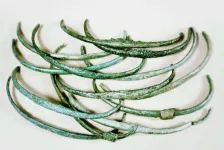
ELSE PRESS RELEASES FROM THIS DATE:
2021-01-20
The onset date of the yearly rainy season reliably predicts if seasonal drought will occur in parts of Sub-Saharan Africa that are particularly vulnerable to food insecurity, and could help to mitigate its effects. Shraddhanand Shukla and colleagues at the University of California, Santa Barbara's Climate Hazards Center, present these findings in the open-access journal PLOS ONE on January 20, 2021.
Climate-driven seasonal drought can impact crop yields and is among major contributors to food insecurity, which can threaten people's lives and livelihoods. In the last ...
2021-01-20
There may be over 34,000 street cattle in the Indian city of Raipur (one for every 54 human residents), with implications for road accidents and human-cattle conflict.
INFORMATION:
Article Title: A population estimation study reveals a staggeringly high number of cattle on the streets of urban Raipur in India
Funding: The author(s) did not receive any specific funding for this work. However, this work is a part of the Doctor of Philosophy thesis of one of the authors, BKS, who is getting a Junior Research Fellowship under the scheme CSIR-UGC NET for JRF [Sr. No. 2121530765. ...
2021-01-20
Fixed dose combinations of antibiotics are consumed in huge quantities globally, but 80 percent of combinations are not on the WHO Essential Medicines List, and 92 percent are not FDA-approved, - with inappropriate combinations risking inefficacy, toxicity, and selection for antimicrobial resistance
INFORMATION:
Article Title: High global consumption of potentially inappropriate fixed dose combination antibiotics: Analysis of data from 75 countries
Funding: We received no specific funding for this work.
Competing Interests: The authors have declared that no competing interests exist.
Article URL: https://journals.plos.org/plosone/article?id=10.1371/journal.pone.0241899
...
2021-01-20
Daddies' girls? Female Bengalese finches prefer their father's song to that of other birds throughout their lives - while sons lose this preference as they grow up.
INFORMATION:
Article Title: Sex differences in the development and expression of a preference for familiar vocal signals in songbirds
Funding: This work was supported by MEXT/JSPS KAKENHI Grant, Numbers 17H06380 to KO & 17J07023 to TGF. The funders had no role in study design, data collection and analysis, decision to publish, or preparation of the manuscript. (https://www.jsps.go.jp/index.html)
Competing Interests: The authors have declared ...
2021-01-20
Boston, Mass. -- Renal cell carcinoma (RCC) is the most common form of cancer of the kidney. In 2018, there were an estimated 403,000 new cases of RCC and 175,000 deaths due to kidney cancer worldwide. Currently, the 5-year survival rate for patients with metastatic RCC is only about 12 percent. Current treatments include inhibitors of the VEGF and PD-1 pathways. However, resistance to therapy occurs in most patients and new combination treatments are still needed to enhance the efficacy of these current approaches.
Now, investigators have demonstrated that ACE2 expression is a good prognostic factor in RCC, that loss ...
2021-01-20
Catnip and silver vine have been known as cat attractant plants. Cat lovers use dry leaves of these plants and toys stuffed with the leaves to give joy to their pet cats. But how does this work? What is the biological significance of the responsive behavior? A research group at Iwate University, Nagoya University, Kyoto University, and University of Liverpool found that the behavior had more practical reasons than getting euphoria.
"The first appearance of silver vine ("Matatabi" in Japanese) as a cat attractant in literature in Japan dates back to more than 300 years ago. A folklore Ukiyo-e drawn in 1859 shows a group of mice trying to tempt some ...
2021-01-20
Scientists at the University of Southampton and University of Edinburgh have developed a flexible underwater robot that can propel itself through water in the same style as nature's most efficient swimmer - the Aurelia aurita jellyfish.
The findings, published in Science Robotics, demonstrate that the new underwater robot can swim as quickly and efficiently as the squid and jellyfish which inspired its design, potentially unlocking new possibilities for underwater exploration with its lightweight design and soft exterior.
Co-author Dr Francesco Giorgio-Serchi, ...
2021-01-20
Researchers at the National Institutes of Health have discovered a new genetic disorder characterized by developmental delays and malformations of the brain, heart and facial features. Named linkage-specific-deubiquitylation-deficiency-induced embryonic defects syndrome (LINKED), it is caused by a mutated version of the OTUD5 gene, which interferes with key molecular steps in embryo development. The findings indicate that the newly identified pathway may be essential for human development and may also underlie other disorders that are present at birth. The information will help scientists better understand such diseases--both common ...
2021-01-20
Researchers have developed an automated method that can track the development of harmful clumps of TAU protein related to Alzheimer's disease in the brain, according to work involving 443 individuals. The method revealed that TAU primarily emerged in an area of the brain called the rhinal cortex before spreading elsewhere, suggesting that targeting TAU here could potentially slow the progression of Alzheimer's disease. The buildup of toxic amyloid-beta and TAU proteins is responsible for many of the symptoms and damage to neurons seen in Alzheimer's disease. However, current therapies have shown reduced efficacy, at least in part because the therapies were administered long ...
2021-01-20
A new Northwestern University study reaffirms the importance of getting a good night's sleep.
By examining fruit flies' brain activity and behavior, the researchers found that deep sleep has an ancient, restorative power to clear waste from the brain. This waste potentially includes toxic proteins that may lead to neurodegenerative disease.
"Waste clearance could be important, in general, for maintaining brain health or for preventing neurogenerative disease," said Dr. Ravi Allada, senior author of the study. "Waste clearance may occur during wake and sleep but is substantially enhanced during deep sleep."
The ...
LAST 30 PRESS RELEASES:
[Press-News.org] On the origins of money: Ancient European hoards full of standardized bronze objects
Early Bronze Age cultures traded in bronze objects of standardized weight

